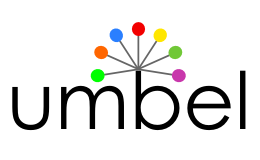| We are happy to announce the new, intermediary, UMBEL version 0.80. This is a major upgrade of the UMBEL ontology: both its vocabulary and its reference structure have been greatly enhanced, an upper structure called the SuperTypes has been added and everything got updated to OWL 2. You can read more about the overall changes on Mike’s blog post. |  |
In this blog post I will focus on two topics: using some existing tools and frameworks to view and manage the reference concepts structure, and how one can use and leverage the coherency of the reference structure.
Navigating and Updating the Reference Structure
One thing that was lacking with the previous version of UMBEL was to have access to a user interface tool that would let you navigate and update the reference structure as you want. Because of the way the conceptual structure was created, it was hard for tools such as Protégé to load it because of all the individuals that were created (such as the SemSet individuals, etc.).
As stated in Mike’s blog post, we made significant changes to the UMBEL vocabulary, and how we instantiate the reference structure. Along with the OWL 2 upgrade, we made sure that the Protégé version 4.1 and the latest version of the OWLAPI could easily load both the UMBEL vocabulary and the reference structure.
Reasoning
One of the major additions to UMBEL v080 is the SuperTypes upper structure, an organizational layer above the UMBEL reference structure. We created these SuperTypes because we found that we could effectively cluster most UMBEL reference concepts into a small set of mostly distinct upper concepts (33 in fact, 29 of which are designed as disjoint).
This new SuperTypes structure helps us mine external sources of information by leveraging related concepts in the reference structure. Moreover, SuperTypes also help us perform easier, simpler, better and faster reasoning over the entire 21 K reference concepts structure.
Thus, SuperTypes provide a new tool to help determine if the UMBEL reference structure is consistent and coherent within itself. This is important, of course, to ensure that linkages between UMBEL and external ontologies is consistent and coherent as well.
So far, the entire reference concepts structure has been tested for its coherency according to the restrictions we defined at the level of the SuperTypes upper structure. Using different reasoners such as Pellet, Fact++ and Hermit (available by default with Protégé 4.1), we made sure that all the statements made between all the RefConcept classes and individuals, and all the statements made between these and the SuperTypes upper structure, are consistent within themselves. This method enabled us to find and fix some early assignment issues.
This new upper structure, along with its now consistent reference structure, helps provide confidence that statements based on UMBEL reference concepts are also consistent. And, all of this is made more testable by virtue of being able to use the OWL API and Protégé with its embedded reasoners.

How is Coherency Tested?
This is the core question. In fact, the more informative answer to this question will be part of a forthcoming blog post. But let’s start here.
The current way to check if the structure is coherent is by making sure that we don’t have an individual that belongs to two different SuperTypes that are stated to be disjoint. What we did with the SuperType upper structure is really simple: we categorized each and every RefConcept (using rdfs:subClassOf) under a SuperType. Most of the SuperTypes are disjoint: this means that if an individual is of rdf:type for two SuperTypes that are stated to be disjoint, then you will end-up with an incoherent structure because you are making a statement that is not permitted by the reference structure.
So, the way to check if your statements are coherent according to this structure, is to make your statements (right now, in terms of individual instantiation), and then to check using a reasoner such as Pellet. There is now a general testing structure to see if any ontology is coherent with respect to the UMBEL reference structure.
In the next blog post in this series, I will tell you how to use exactly the same method for coherency testing, but now for testing if linkages between external ontologies and the UMBEL reference structure are consistent. In that case, you will make the class-to-class assertions you want, and then you will instantiate individuals of these classes, then run the reasoner. Then, the reasoner will tell you if your ontology is still consistent according to the structure and the new statements you created.
Next Step
In parallel with these tutorials, we are also working hard on the next version of UMBEL. As outlined in the Next Changes section of the new UMBEL website, the next step is to release UMBEL v1.0, with a set of new features, before Christmas.